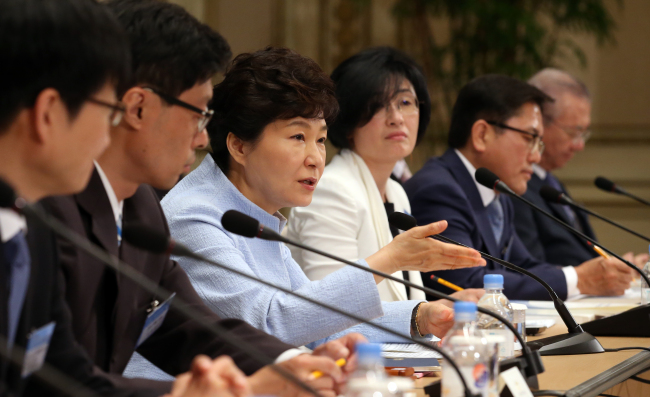Korea to ease foreign investment rules
Korea to gradually open 29 industries to FDI and loosen regulations on greenbelt land use
By Korea HeraldPublished : May 6, 2015 - 18:59
The government plans to open up more local industries to foreign companies and cut red tape in greenbelt land use in its efforts to boost sagging foreign direct investment and revive the economy.
The plans were revealed after the third ministerial meeting on regulatory reform presided over by President Park Geun-hye at Cheong Wa Dae on Wednesday.
Park called for a market-friendly regulatory environment, which she hoped would lead to job creation and growth.
She expressed regret about the National Assembly’s failure to pass a set of economic stimulus package bills, including one to promote tourism, saying hundreds of thousands of jobs for young people depended on the bills.
The meeting also highlighted cutting red tape for foreign direct investment.
The plans were revealed after the third ministerial meeting on regulatory reform presided over by President Park Geun-hye at Cheong Wa Dae on Wednesday.
Park called for a market-friendly regulatory environment, which she hoped would lead to job creation and growth.
She expressed regret about the National Assembly’s failure to pass a set of economic stimulus package bills, including one to promote tourism, saying hundreds of thousands of jobs for young people depended on the bills.
The meeting also highlighted cutting red tape for foreign direct investment.

In an effort to boost foreign direct investment, officials said the government would more drastically remove obstacles facing foreign investors by gradually or partially opening up 29 restricted sectors to foreign capital.
The government has set a goal of increasing FDI by 60 percent to $30 billion (32.4 trillion won) by 2017 from $19 billion in 2014.
“The government will seek to lift barriers against the inflow of foreign capital, workforce and technology into Korea,” said Trade, Industry and Energy Deputy Minister Kwon Pyung-oh, who is in charge of international trade and investment.
“In line with this policy direction, Korea will open up the aircraft maintenance repair and overhaul business to foreign competition,” Kwon said.
Under the current aviation law, foreign ownership in an MRO company in Korea is limited to 50 percent, as aviation is one of 29 sectors where foreign investors have limited access.
Industry watchers predict that the opening of restricted sectors, including media and nuclear power, however, will still take considerable time, given their sensitivity linked to public or national interests.
“The ministry plans to review 29 restricted sectors for market opening in the second half of this year, but it seems to be difficult to allow a second sector soon after the MRO business,” a MOTIE official said under condition of anonymity.
In an effort to raise industrial competitiveness, the ministry is also working with the Ministry of Justice to develop a new type of visa for foreign professionals in the service sectors.
“The new visa will bring skilled foreign trainers in the service sectors where Korea has room for development,” Kwon said.
Design and software businesses are sectors that often want to hire foreign lecturers, ministry officials said.
In addition, the Industry Ministry vowed to deregulate sectors with growth potential such as cosmetics, bio-industry and parts and materials businesses.
Beyond the FDI sector, the government decided to ease regulations on land use in greenbelt areas near cities, where construction is heavily restricted.
The government said it would simplify procedures for the greenbelt land use in response to the opinion of citizens living nearby. Previously, development projects in greenbelt areas, which account for 3.9 percent of the nation’s total land, had been tightly restricted except for a few cases for public housing or industrial site projects, led by the central government.
Land Ministry officials said the central government would give authority to provincial governments on whether to remove land from greenbelt classification. But such reclassification would only be possible for areas of land under 300,000 square meters in size.
By Seo Jee-yeon (jyseo@heraldcorp.com)
-
Articles by Korea Herald



















